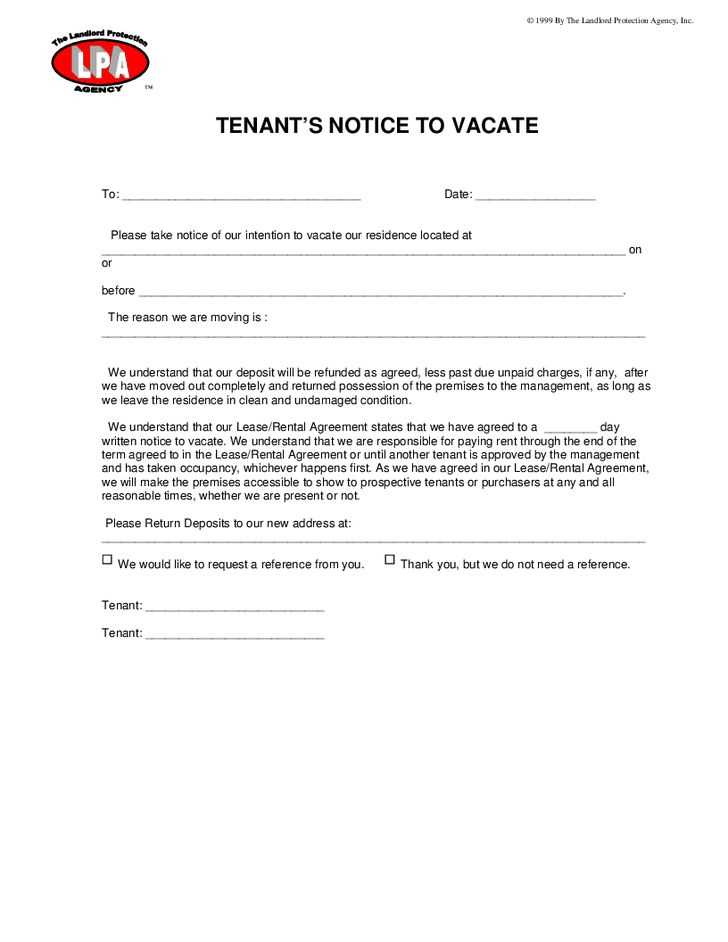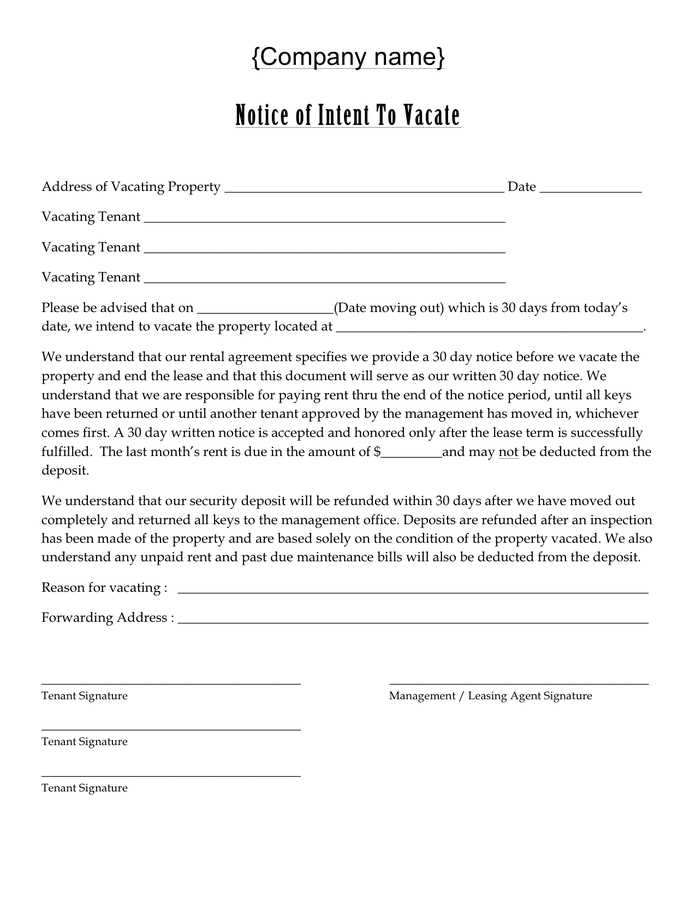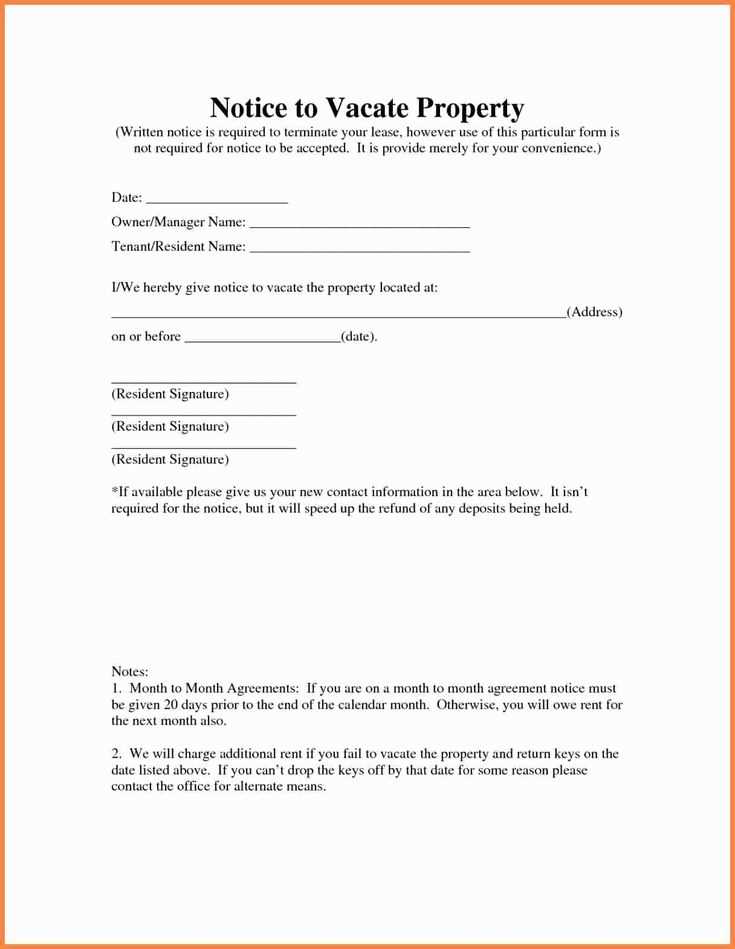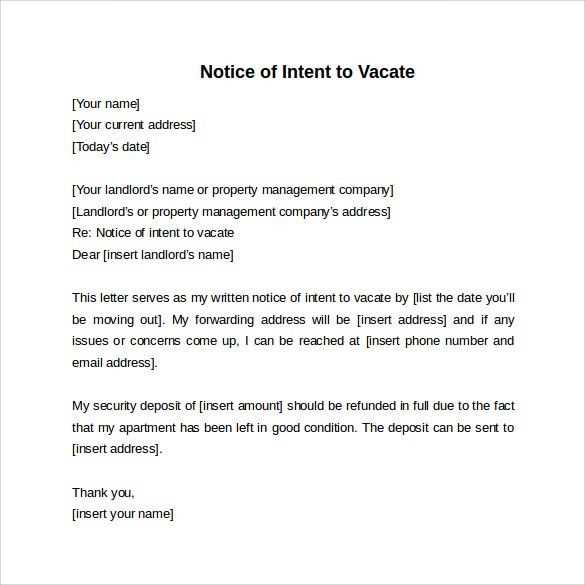Letter to Vacate Property Template for Easy Tenant Notifications

Notifying a tenant about the need to leave a rented space requires clear and professional communication. This process is essential to ensure that all parties understand the terms and deadlines involved in the transition. A well-crafted document helps to avoid confusion and potential disputes, providing a smooth conclusion to the rental agreement.
Knowing how to structure the notification is crucial. It should include key details such as the final date of occupancy, any requirements for the return of the space, and any obligations that must be fulfilled before departure. A formal yet respectful tone ensures clarity and maintains a positive relationship between the landlord and tenant.
Having a ready-made structure for such notices can save time and ensure that nothing is overlooked. Whether you’re dealing with a lease termination or a similar situation, having a precise format makes the process more efficient for both parties involved.
Importance of Sending a Vacate Notice
Notifying tenants about the need to leave the rented space is a critical part of the leasing process. Without proper communication, misunderstandings and disputes can arise, creating complications for both landlords and tenants. A well-structured notification is key to ensuring that both parties are aligned and that all requirements are met smoothly before the end of the lease term.
Legal and Contractual Obligations
Sending a formal notice is often a legal requirement, depending on the terms of the rental agreement. In many regions, landlords must provide a certain amount of notice before a tenant can be expected to leave. Failing to meet this obligation could lead to legal consequences or the inability to claim damages if the tenant refuses to vacate the space.
Ensuring Smooth Transitions
Clear communication allows both parties to prepare for the move-out process. By informing tenants well in advance, landlords give them ample time to organize their relocation. This reduces the risk of last-minute issues and helps ensure that the space is returned in the condition specified in the agreement.
Timely notifications also provide tenants with the opportunity to ask questions or clarify any details. A thoughtful, advanced notice minimizes confusion and sets the stage for a respectful end to the leasing arrangement.
Step-by-Step Guide to Writing a Letter
When crafting a formal notification to inform a tenant about their required departure, it is important to follow a clear structure. A well-organized document ensures all relevant information is included, reducing the risk of confusion and providing the tenant with necessary details about the transition. Below is a step-by-step guide on how to write a precise and effective notice.
1. Start with a Formal Greeting
Begin by addressing the tenant using their full name and a respectful salutation. This establishes a professional tone right from the start. Using formal language helps maintain a positive relationship between both parties.
2. Clearly State the Intent

The purpose of the communication should be made clear early in the document. Clearly state that you are informing the tenant of their obligation to leave the rented space. Be concise but firm, specifying any important dates, such as when the tenant is expected to leave.
Include essential details such as the date of occupancy termination, any steps that need to be taken by the tenant, and any obligations that remain before the final move. Providing all relevant information helps prevent misunderstandings.
Ensure the document is free of ambiguity to avoid unnecessary back-and-forth. This clarity supports a smooth transition for both parties involved.
Essential Elements in a Vacate Letter
For an effective notification to leave the rented space, certain critical elements must be included to ensure clarity and completeness. These components ensure that the tenant receives all the information necessary for a smooth transition. Without these key elements, misunderstandings or confusion can easily arise.
1. Tenant and Landlord Information
Start by providing the full names and addresses of both parties. This includes the tenant’s current residence details and the landlord’s contact information. This establishes who the notice is directed to and ensures there is no ambiguity about the involved parties.
2. Date of Occupancy Termination
Clearly state the date on which the tenant is expected to vacate. This date is crucial for both the landlord and tenant to ensure proper planning and avoid disputes. It’s also important to note whether this date aligns with the terms outlined in the original lease agreement.
Additional instructions may also be included, such as how to return keys or any necessary cleaning requirements. Providing these details upfront helps avoid confusion and ensures the tenant is fully prepared for their move-out.
Having all these key details in place makes the communication professional and clear, establishing a solid foundation for a respectful conclusion of the rental arrangement.
How to Customize Your Template
Customizing a notification for tenants is an essential step to ensure it aligns with the specific needs of both parties. By tailoring the format and content, you can address individual circumstances and ensure clarity. The customization process involves making adjustments to details, tone, and structure to reflect the unique rental agreement.
1. Personalize the Details

- Update the tenant’s full name and address.
- Include the specific date the tenant is expected to leave.
- Ensure any additional instructions, such as key return or cleaning guidelines, are relevant to the current situation.
2. Adjust the Tone

Modify the tone of the notification based on the relationship with the tenant. If it is a formal, business-like arrangement, maintain a professional tone throughout. However, if the tenant is someone with whom you have a friendly rapport, a more relaxed and cordial tone may be appropriate.
3. Include Relevant Legal or Lease Terms
- Reference the lease agreement or any clauses that are relevant to the move-out process.
- Make sure to mention any legal requirements or deadlines that apply in your region.
By following these steps, you can ensure that the notification is clear, appropriate, and legally sound, fostering a smooth transition for both parties.
Common Mistakes to Avoid in Letters
While writing a formal notification for a tenant to leave a rental space, several common errors can lead to confusion or legal issues. Being aware of these pitfalls helps ensure that the document serves its intended purpose, with clear communication and no room for misinterpretation. Below is a table outlining some of the most frequent mistakes and how to avoid them.
| Mistake | How to Avoid |
|---|---|
| Vague Language | Be specific about dates, obligations, and expectations. Avoid using ambiguous phrases like “soon” or “later.” |
| Missing Tenant Information | Ensure that the tenant’s full name, address, and other details are correctly included to avoid confusion. |
| Unclear Deadlines | Clearly state the final date the tenant is expected to leave and the exact terms for vacating the space. |
| Overly Casual Tone | Keep the tone formal and professional, especially if it’s a legal requirement or serious matter. |
| Omitting Legal Requirements | Ensure that all local laws or lease terms regarding tenant departure are referenced and followed. |
Avoiding these mistakes helps create a document that is clear, respectful, and legally sound, reducing the chances of misunderstandings or disputes with tenants.
When to Send a Vacate Letter
Timing is crucial when informing a tenant about the need to leave a rented space. Sending the notification too early may confuse the tenant, while waiting too long could cause unnecessary delays. The goal is to provide enough notice for the tenant to make the necessary preparations while also ensuring compliance with the terms outlined in the lease agreement.
Check local laws and lease agreements to determine the required amount of notice. In many areas, landlords must provide a certain period before expecting the tenant to leave, typically ranging from 30 to 60 days. Failing to adhere to these guidelines could result in legal complications.
Ideally, send the notice well in advance to allow the tenant sufficient time to arrange for a move and fulfill any other obligations, such as returning keys or cleaning the space. Giving ample notice also helps maintain a professional and respectful relationship throughout the process.